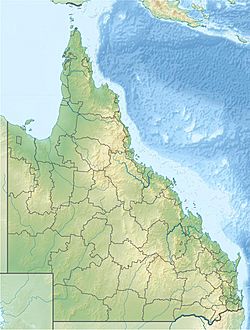Moreton Bay Pile Light facts for kids
 |
|
| The first Moreton Bay Pile Light ca. 1880 | |
|
|
|
| Location | Moreton Bay Queensland Australia |
|---|---|
| Coordinates | 27°19′28″S 153°10′12″E / 27.32444°S 153.17000°E |
| Year first constructed | 1884 (first) 1913 (second) 1952 (third) |
| Automated | 1952 |
| Deactivated | 1913 (first) 1952 (second) 1966 (third) |
| Foundation | steel piles |
| Construction | wrought and cast iron |
| Tower shape | hexagonal frustum keeper's house with the lantern on the roof |
| Focal height | 44 feet (13 m) (first) 22 feet (6.7 m) (third) |
| Original lens | 4th order dioptric |
| Characteristic | Oc W 12s. (first and second) Fl WR 3s (third) |
| ARLHS number | AUS-112 |
The Moreton Bay Pile Light was a special kind of lighthouse in Moreton Bay, Queensland, Australia. It stood at the entrance to the Brisbane River, helping ships find their way into the port of Brisbane. This lighthouse was built on tall poles, like stilts, which is why it was called a "pile light."
Its story is linked to how the Brisbane River was made deeper for ships, a process called dredging. The first light was set up in 1884. It had to be moved in 1913 when the shipping channels changed. The lighthouse was badly damaged by a barge in 1945. It was then completely destroyed when a large tanker hit it in 1949. An automated light worked on the remains until it was finally removed around 1966 or 1967.
Contents
The First Moreton Bay Pile Light (1884-1913)
The Brisbane River needed to be deeper for ships to reach the Brisbane Port. So, in 1862, work began to dredge, or dig out, a channel. A new channel was finished in 1883.
This new channel needed a new light. The old lightship Rose, which was 40 years old, was not suitable. So, a new lighthouse was built by government workers. It was located at 27°19′28″S 153°10′12″E / 27.32444°S 153.17000°E.
Building the First Lighthouse
The first pile light was designed by George Poynter Heath. He was the Portmaster for Queensland. The building was shaped like a hexagon and had six rooms. It was about 98 feet (30 m) tall.
Seven strong poles, or piles, held the structure up. These piles were made of wrought iron. They were screwed 24 feet (7.3 m) deep into the mud. The water around them was about 16 feet (4.9 m) deep at low tide.
How the First Light Worked
The lighthouse started working on May 31, 1884. A telegraph line to Brisbane was added later, on August 8. The light used a special 4th order dioptric lens. It shone 44 feet (13 m) above the high-water mark.
The light had a special pattern: it would go dark for two seconds every 12 seconds when the tide was coming in (flood tide). It stayed on all the time when the tide was going out (ebb tide). The light also showed different colors. It was white when ships were in the deep channel. It turned red if they were not.
The lighthouse also helped ships know about the tide. During the day, two special signals on the building showed the tide level. At night, two smaller lights with different colors showed the tide. These colors were changed by hand. The lighthouse also automatically recorded the tide levels. These records were sent to Greenwich every month.
The Second Moreton Bay Pile Light (1913-1952)
In 1901, a plan was made to make the channel even better. A new path for ships was dug starting in 1908. This new channel was finished by October 1, 1912. Because of this new path, the first pile light had to be moved.
Building the Second Lighthouse
The old lighthouse was stopped on February 11, 1913. A small light was left on the old platform for a while. The new light was built at 27°18′45″S 153°12′40″E / 27.31250°S 153.21111°E. It started shining on June 27, 1913.
Building this new light was tricky because the mud was very soft. Test poles sank 20 feet (6.1 m) just by their own weight! The new lighthouse was built on strong reinforced concrete piles. These piles were driven 41 feet (12 m) into the mud. About 5,000 long tons (5,100 t) of sand were also dumped around the area to help.
The lens from the old lighthouse was moved to the new one. The light kept the same pattern: going dark for two seconds every 12 seconds during flood tide, and staying on otherwise. It also kept the colored sectors and the tide signals.
Damage and Destruction of the Second Light
On March 3, 1945, the pile light was badly damaged. A US refrigerated barge, pulled by a tugboat, hit it. The lighthouse keepers stayed at their posts. The lighthouse was repaired, but some damage remained.
Then, on October 17, 1949, a huge British tanker called Wave Protector crashed into the lighthouse. It completely destroyed the structure. The three light keepers were thrown into the water. Luckily, a lifeboat from the Wave Protector rescued them.
The Third Moreton Bay Pile Light (1952-1966)
After the second lighthouse was destroyed, a third one was built. It was finished in late 1952. This third lighthouse was built on the same spot as the destroyed second one. It even used some of the old steel piles for its foundation.
This new light was fully automated, meaning no people lived or worked there. It used an acetylene gas lamp. The light shone 22 feet (6.7 m) high. Its pattern was one flash every three seconds. It showed white light in certain directions and red light in others. The third pile light was finally removed in 1966 or 1967 by a barge called Hammerhead.



